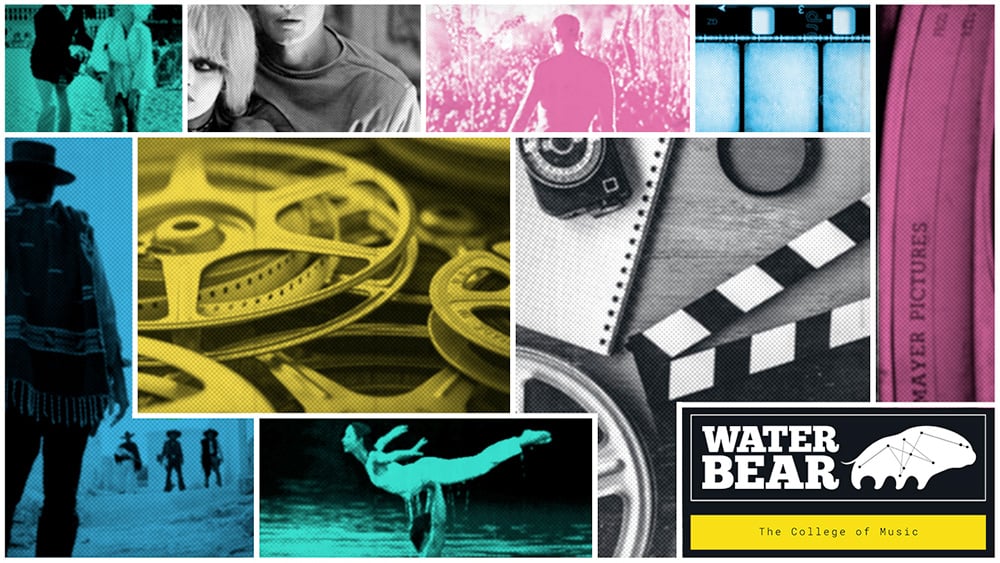JOIN US SEPTEMBER 2024 - APPLY TODAY OR BOOK YOUR PLACE ON ONE OF OUR OPEN DAYS IN BRIGHTON OR SHEFFIELD. UCAS CLEARING IS NOW OPEN.
JOIN US SEPTEMBER 2024 - APPLY TODAY OR BOOK YOUR PLACE ON ONE OF OUR OPEN DAYS IN BRIGHTON OR SHEFFIELD. UCAS CLEARING IS NOW OPEN.

Writing music for film and television can seem like a book of seven seals. We collectively watch a huge amount of content. And, whether it's on the big or the small screen, not much is generally known about the actual work of writing music for film. So, lets take a look at some of the principles and misconceptions behind making music for film.
Unlike music that is made to be listened to on its own, music for film and television is a narrative . It helps tell stories. If you want to learn about it, a good place to start is to study how stories are told. In particular you might want to look at key concepts such as 3-act structure, character development and the famous “hero’s journey”.
Another important aspect of making films is how they are edited. Pay close attention to the transitions between different shots next time you watch a film or a TV show. How often do cuts occur?
Is there a rhythm to them or do they seem chaotic and random? Do the changes in the picture happen in time with the music. Do they seem to have their own logic? All these questions can help you understand how music and the grammar of film (editing, lights, camera angles etc) work together.
Here is some Suggested reading on storytelling and filmmaking.
The Hero’s Journey by Christopher Vogler.
The Seven Basic Plots by Christopher Booker.
Making Movies by Sidney Lumet.
In the Blink of an Eye by Walter Murch
Only a small fraction of film and TV music has the classic, recognisable big budget Hollywood sound that includes a 90-piece orchestra and expensive-sounding electronics. In reality there are many different styles of writing music to picture. And, many successful composers from a range of different musical backgrounds.
A common beginner’s mistake is to put a lot of effort into emulating a default Hollywood style - an exclusive 0.5% of the total film-musical output. By way of example, there are hundreds of YouTube videos explaining how to recreate certain aspects of Hans Zimmer’s sound.
A much more interesting route to go down is to work out what your own musical background can bring to the table for film/TV. Maybe you play a particular instrument that can be used for good effect on intimate dramas. Or perhaps, you’re really good at creating ambient textures. The point is to find a way that is personal and unique to you which you can use to differentiate yourself and find a niche that speaks to your inclinations and abilities.
Having recognised that there are many different ways of approaching film music, it’s nonetheless very important to acknowledge that there is an existing tradition behind this variety. Film music as we know it began in the 1930s. Viennese light classical composers such as Erich Korngold moved to LA and brought with them their knowledge of harmony, counterpoint and orchestration.
Because of these historical roots in classical music, there are certain stylistic conventions that are taken for granted. String sections, for example, are the most used instrument type in film music by far. This is due to their versatility, and the long history of strings being used in film music.
It is therefore essential to have at least a basic grasp of what sections constitute an orchestra. Namely woodwind, brass, percussion and strings. Research how to produce some, more or less, convincing sounds with it. Granted, if you’re starting out you’re most likely to use sampled (virtual) orchestral instruments to begin with. But it still makes sense to get to know this way of working as samples are used even in high-end productions these days (including Star Trek Discovery).
Now that you know a few basic things about the orchestra and the use of samples, it’s time to broaden your horizon. Always keep an open mind and learn more about musical styles, instruments or production techniques. Whether it’s a student film that requires you to dig out some 1960s Motown records for inspiration or an advert that needs to be scored in an uplifting EDM style, you can never go wrong by being able to quickly and convincingly mimic a particular musical tradition.
Top tip: practice analysing and recreating short pieces from 5 totally different musical styles with 48h deadlines. This will give you practice in responding to a brief/request for a demo outside of your comfort zone!
I often get asked how easy it is to get a foot in the door in the film/TV/media scoring industry. Unfortunately, there is no easy answer! Writing music for media is not like medicine or law. An exam cannot prepare and qualify you for the world of work. Instead, composing for film is much more like acting, where even talented newcomers need to spread their skills far and wide to get noticed at the beginning.
Films are made by people, however, and it’s this knowledge you can use to your advantage. By collaborating at an entry-level with emerging or student filmmakers you can gain experience, make a name for yourself in a small community, and build your portfolio at the same time.
For example, you might consider approaching a film college or course near you and offer to do some music for free for their student films. Some graduation films end up having a good run on the festival circuit. They can end up being seen by quite a large number of people in the industry, so your energy is unlikely to be wasted completely.
Here are some film colleges.
University of the Creative Arts.
Ravensbourne University London.
Robin Schlochtermeier is composer for film, television and advertising based in London, UK.www.robinschlochtermeier.com
If you interested in learning more and are serious about progressing in your career as a musician, Order a Prospectus or Apply Now.

- ‘Water bear’ is the common name for a Tardigrade.
- Tardigrades are micro creatures, found everywhere on earth.
- They are the most resilient creatures known.
- They can survive and adapt to their surroundings, even in outer space.
- Their resilience and ability to adapt and survive inspires us in everything we do. We love them.


WaterBear Education Ltd, Hanover House,
118 Queens Road, Brighton BN1 3XG, UK Map
Email: [email protected]
Tel: +44 (0) 1273 726230
WaterBear Sheffield, Unit 4, Gatecrasher,
49 Eyre Lane, Sheffield S1 4RB, UK
Email: [email protected]
Tel: +44 (0) 1143 992720

WaterBear Education Ltd, Hanover House,
118 Queens Road, Brighton BN1 3XG, UK Map
Email: [email protected]
Tel: +44 (0) 1273 726230
WaterBear Sheffield, Unit 4, Gatecrasher,
49 Eyre Lane, Sheffield S1 4RB, UK
Email: [email protected]
Tel: +44 (0) 1143 992720
- ‘Water bear’ is the common name for a Tardigrade.
- Tardigrades are micro creatures, found everywhere on earth.
- They are the most resilient creatures known.
- They can survive and adapt to their surroundings, even in outer space.
- Their resilience and ability to adapt and survive inspires us in everything we do. We love them.
